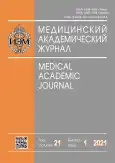Features of the Development and Application of Diagnostic ELISA Systems for the Detection of Antibodies to the SARS-CoV-2 Coronavirus in Clinical Practice
- Authors: Zagoruyko E.I.1, Kudlay D.A.1,2, Lysenko M.A.3,4, Fomina D.S.2,4,5, Vinogradov I.V.6, Bogachev V.V.6, Starostenko A.A.7
-
Affiliations:
- GENERIUM
- I.M. Sechenov First Moscow State Medical University (Sechenov University)
- N.I. Pirogov Medical University
- City Clinical Hospital No. 52
- Moscow City Health Department
- MBU-Technology
- Medical Biological Union
- Issue: Vol 21, No 1 (2021)
- Pages: 19-30
- Section: Original research
- URL: https://ogarev-online.ru/MAJ/article/view/59240
- DOI: https://doi.org/10.17816/MAJ59240
- ID: 59240
Cite item
Abstract
Introduction. The new coronavirus infection, COVID-19, caused by SARS-CoV-2 has reached the scale of a pandemic. Detection of antibodies to SARS-CoV-2 is an aid in the diagnosis of COVID-19, and is also used to assess the immune response to the infection. Since COVID-19 is a new disease, seroconversions and kinetics of antibody to SARS-CoV-2 are not well understood.
The aim of the study is to evaluate seroconversions and kinetics of antibodies to SARS-CoV-2 (IgA, IgM, IgG and total) in real clinical practice using test systems of national production.
Materials and methods. 327 blood samples obtained from patients with a confirmed diagnosis of COVID-19 with active infection, convalescents and healthy donors were analyzed. Detection of antibodies to SARS-CoV-2 was carried out by enzyme immunoassay method using registered test systems “Antigma-A”, “Antigma-G”, “Antigma-Screen” and an unregistered test system for the detection of class M immunoglobulins.
Results. When testing for total antibodies, 50.0% of samples were positive on days 1-7; 89.4% on days 8-14; 96.2% on days 15-45; and 93.3% after the 46th day after disease onset. The earliest seroconversions occurred on the 3rd day; antibodies were detected up to 81 days after the disease onset.
Conclusions. The frequency of detecting seroconversions when using test systems of the “Antigma” series in real clinical practice is comparable to the data published in the world scientific literature and is high enough to use these test systems in the COVID-19 diagnostics.
Keywords
Full Text
##article.viewOnOriginalSite##About the authors
Elena I. Zagoruyko
GENERIUM
Author for correspondence.
Email: eizagoruiko@generium.ru
Senior Clinical Research Manager, Scientific Department
Russian Federation, MoscowDmitriy A. Kudlay
GENERIUM; I.M. Sechenov First Moscow State Medical University (Sechenov University)
Email: dakudlay@generium.ru
MD, PhD, DSc (Medicine), Professor of the Pharmacology Department, Institute of Pharmacy, Vice President, New Medical Technology Implementation
Russian Federation, MoscowMaryana A. Lysenko
N.I. Pirogov Medical University; City Clinical Hospital No. 52
Email: gkb52@zdrav.mos.ru
MD, PhD, DSc (Medicine), Professor of the General Internal Medicine Department, Faculty of Additional Professional Education, Head Physician
Russian Federation, MoscowDarya S. Fomina
I.M. Sechenov First Moscow State Medical University (Sechenov University); City Clinical Hospital No. 52; Moscow City Health Department
Email: daria_fomina@mail.ru
MD, PhD (Medicine), Associate Professor of the Clinical Immunology and Allergology Department, Chief External Specialist in Allergology and Immunology, Chief of the Allergology and Immunology Center
Russian Federation, MoscowIlya V. Vinogradov
MBU-Technology
Email: vinogradov@mbu-tech.com
MD, PhD (Biology), R&D scientist
Russian Federation, NovosibirskVladislav V. Bogachev
MBU-Technology
Email: bogachev@mbu-tech.com
MD, PhD (Biology), R&D scientist
Russian Federation, NovosibirskAlena A. Starostenko
Medical Biological Union
Email: starostenko.alena@gmail.com
Leading Specialist of the Medical Devices Registration Department
Russian Federation, NovosibirskReferences
- Hu B, Guo H, Zhou P, et al. Characteristics of SARS-CoV-2 and COVID-19. Nat Rev Microbiol. 2020;6:1–14. doi: 10.1038/s41579-020-00459-7
- Huang AT, Garcia-Carreras B, Hitchings MDT, et al. A systematic review of antibody mediated immunity to coronaviruses: kinetics, correlates of protection, and association with severity. Nat Commun. 2020;11(1):4704. doi: 10.1038/s41467-020-18450-4
- Vremennye metodicheskie rekomendatsii “Profilaktika, diagnostika i lechenie novoi koronavirusnoi infektsii (COVID-19)”. Ministerstvo zdravookhraneniya Rossiiskoi Federatsii. Versiya 9 ot 26.10.2020 g. Available from: https://static-0.minzdrav.gov.ru/system/attachments/attaches/000/052/548/original/%D0%9C%D0%A0_COVID-19_%28v.9%29.pdf?1603730062. (In Russ.)
- Deeks JJ, Dinnes J, Takwoingi Y, et al. Antibody tests for identification of current and past infection with SARS-CoV-2. Cochrane Database Syst Rev. 2020;6(6):CD013652. doi: 10.1002/14651858.CD013652
- Murchu EO, Byrne P, Walsh KA, et al. Immune response following infection with SARS-CoV-2 and other coronaviruses: a rapid review. Rev Med Virol. 2020;e2162. doi: 10.1002/rmv.2162
- Demey B, Daher N, François C, et al. Dynamic profile for the detection of anti-SARS-CoV-2 antibodies using four immunochromatographic assays. J Infect. 2020;81(2):e6–e10. doi: 10.1016/j.jinf.2020.04.033
- Hou H, Wang T, Zhang B, et al. Detection of IgM and IgG antibodies in patients with coronavirus disease 2019. Clin Transl Immunology. 2020;9(5):e01136. doi: 10.1002/cti2.1136
- La Rosa Fabián C, Urquizo Briceño L. Anti-SARS-Cov-2 IgA in current scenario of IgM and IgG rapid test: a new alternative for the diagnostic of COVID-19. SN Compr Clin Med. 2020;2:2167–2169. doi: 10.1007/s42399-020-00551-2
- Ma H, Zeng W, He H, et al. Serum IgA, IgM, and IgG responses in COVID-19. Cell Mol Immunol. 2020;17(7):773–775. doi: 10.1038/s41423-020-0474-z
- Yu HQ, Sun BQ, Fang ZF, et al. Distinct features of SARS-CoV-2-specific IgA response in COVID-19 patients. Eur Respir J. 2020;56(2):2001526. doi: 10.1183/13993003.01526-2020
- Padoan A, Sciacovelli L, Basso D, et al. IgA-Ab response to spike glycoprotein of SARS-CoV-2 in patients with COVID-19: A longitudinal study. Clin Chim Acta. 2020;507:164–166. doi: 10.1016/j.cca.2020.04.026
- Ma H, Zhao D, Zeng W, et al. Decline of SARS-CoV-2-specific IgG, IgM and IgA in convalescent COVID-19 patients within 100 days after hospital discharge. Sci China Life Sci. 2020;1–4. doi: 10.1007/s11427-020-1805-0
- Ni L, Ye F, Cheng ML, et al. Detection of SARS-CoV-2-specific humoral and cellular immunity in COVID-19 convalescent individuals. Immunity. 2020;52(6):971–977.e3. doi: 10.1016/j.immuni.2020.04.023
- Robbiani DF, Gaebler C, Muecksch F, et al. Convergent antibody responses to SARS-CoV-2 infection in convalescent individuals. bioRxiv. 2020;13:092619. doi: 10.1101/2020.05.13.092619
- Wu F, Wang A, Liu M, et al. Neutralizing antibody responses to SARSCoV-2 in a COVID-19 recovered patient cohort and their implications. medRxiv. 2020. doi: 10.1101/2020.03.30.20047365
Supplementary files








